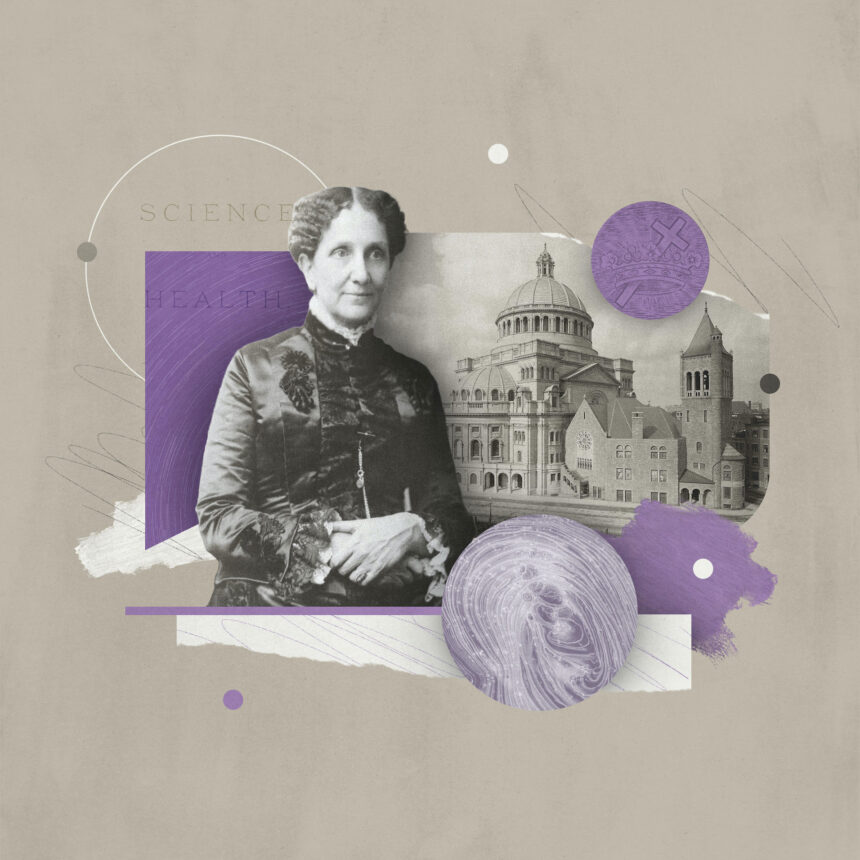(Image of Mary Baker Eddy. Image source: ligonier.org/)
“It’s a good religion,” my grandmother liked to say to her daughter, my mother. Grandma Raedina was Jewish, as were all my relatives on both sides of the family. But in this case the religion she was touting wasn’t Judaism. It was Christian Science.
The connection between Jews and Christian Science has mostly been forgotten. But my grandmother’s flirtation with Christian Science wasn’t unusual. In the early years of the 20th century, a substantial number of Jewish Americans, especially Jewish women, joined Christian Science churches, sometimes abandoning Judaism, but more often just adding Christian Science to their Jewish identities.
Jewish institutions and Jewish leaders have not been especially interested in discussing, much less celebrating, the connection between Judaism and Christian Science. Growing up, my mom occasionally mentioned that my grandmother had been interested in Christian Science. I had only the vaguest idea of what Christian Science was, and no way to know that it had attracted many Jews, not just Grandma Raedina. Christian Science seemed like my grandmother’s individual personality quirk, rather than an expression of a social trend, or of a certain kind of Jewish identity.
I only started thinking about my family’s relationship to Christian Science in the last few years, and especially in the last few months. Like many Jewish people in the United States, I’ve been forcibly reminded of how central Zionism is to American Jewish life. I’ve also been reminded of how alienating I find that centrality. I’ve never identified strongly with Israel, and to me its current actions in Gaza are unconscionable. My relatives were virtually all in the United States long before Israel existed—experimenting with Christian Science in some cases.
I can’t say I identity strongly with Christian Science either; I’m not much for faith healing. Finding alternatives to Zionism in Jewish life, though, means taking diaspora seriously, and that means finding a way to talk about assimilation, syncretism, and heterodoxy that doesn’t begin and end with disavowal. I don’t want to be a Christian Scientist. But I’ve been trying to find out why many American Jewish women like my grandmother, at least intermittently, did.
My Jewish Christian Scientist Ancestors
Christian Science was founded in the United States in 1879 by Mary Baker Eddy. Eddy believed the physical world was essentially an illusion, created by the weakness of the human mind. Therefore illness and misfortune were a kind of unreal human projection. Through faith and prayer, Christian Scientists could cast aside the illusion of sickness and reestablish the real, authentic truth of health. Christian Scientists generally embraced faith healing, and often (though not always) refused to see traditional doctors.
 How many Jewish people turned to Christian Science? Exact numbers are difficult to come by, but at the height of Christian Science’s growth in the early 20th century, the number of Jewish adherents was probably in the thousands, and may have numbered as many as 40,000, according to Ellen M. Umansky’s 2005 monograph From Christian Science to Jewish Science: Spiritual Healing and American Jews. Even if Umansky’s highest estimate is accurate, Jewish converts to Christian Science involved at most 0.5 percent of the 3 million Jews living in the U.S. in the 1910s. Nonetheless, the rapid rise of Christian Science at the time alarmed many Jewish observers.
How many Jewish people turned to Christian Science? Exact numbers are difficult to come by, but at the height of Christian Science’s growth in the early 20th century, the number of Jewish adherents was probably in the thousands, and may have numbered as many as 40,000, according to Ellen M. Umansky’s 2005 monograph From Christian Science to Jewish Science: Spiritual Healing and American Jews. Even if Umansky’s highest estimate is accurate, Jewish converts to Christian Science involved at most 0.5 percent of the 3 million Jews living in the U.S. in the 1910s. Nonetheless, the rapid rise of Christian Science at the time alarmed many Jewish observers.
One of the Jews who embraced Christian Science was my great grandmother, Hattie Davidson. Born in the U.S. in 1887 to Samuel Davidson, a Lithuanian Jewish immigrant, and Sarah Masser, who immigrated from somewhere in Eastern Europe, Hattie was the eldest of eight siblings. Hattie’s husband Abe Davidson, a tailor and milliner, was born in Suwalk, Russia in 1883 and came to the U.S. 18 years later. The two met in Chicago, where Hattie grew up, and married in 1910. Raedina was born two years later, when Hattie would have been 25.
Hattie, according to family lore, was beautiful, intelligent, and for most of her life, very unhappy. She attended business school but rarely worked outside the home except for a short stint in an office job during World War II. She loathed housework and didn’t seem to like her marriage either. She stayed with my mother’s parents towards the end of her life in the early 1960s, and my mother remembers her as cranky and miserable, though that could have been in part due to her worsening health.
Why Christian Science?
Exactly how and when Hattie became involved in Christian Science is unclear. Since her sisters were also adherents, it’s possible that their mother introduced it to them when they were children.
Contemporary Jewish observers in the 1900s suggested that Jews were attracted to Christian Science as a way of assimilating and shedding the stigma and antisemitism associated with Jewish identity. Umansky quotes a hostile 1913 editorial in the American Hebrew which insists that Christian Science for Jews was a “fashionable fad adopted” by Jewish people because of its “social element.” In other words, Jewish people joined because the church allowed for upward mobility.
The transition to Christian Science was relatively easy in comparison to conversion to other Christian denominations. Christian Science didn’t require baptism, didn’t make much of the iconography of the cross, and didn’t have traditional clergy. As a new form of Christianity, it also didn’t have painful or historical associations with antisemitism: Christian Scientists had not burned and beaten Jews in Russian or Lithuanian pogroms. The emphasis on spirituality and healing allowed some Jewish people to convince themselves that Jesus wasn’t really central to the faith—though in fact Mary Baker Eddy’s devotion to Jesus pervaded Christian Science worship, and the church required members to forswear previous congregational affiliations, including to Jewish synagogues.
Christian Science, then, was a relatively painless way to negotiate a less Jewish identity that might be more acceptable in a society controlled by Christians.
Umansky contends that the focus on social climbing and assimilation in joining Christian Science is exaggerated. She states that the primary reason, if not the only reason, for American Jews joining the religion was the attraction to its spirituality. Orthodox synagogues in the US were centered on rituals, while Reform synagogues focused on social justice and ethics, leaving many Jews feeling unfulfilled in their religious yearnings.
Quoting Rabbi Max Heller and Reform Rabbi Stephen Wise, Umansky highlights the lack of emphasis on spirituality in Jewish religious institutions. This led many Jewish women to turn to Christian Science, where they found a focus on spirituality and a recognition of women’s leadership. The appeal of Christian Science to Jewish women led to the creation of “Jewish Science,” an attempt to adapt Christian Science to a Jewish context.
Christian Science’s promise of healing also appealed to Jewish women, who may have felt let down by traditional medicine. However, the growth of Christian Science declined in the 1930s and 40s, coinciding with advancements in modern medicine and increasing opportunities for women in other denominations.
Despite her brief exposure to Christian Science Sunday school, the author’s mother ultimately embraced her Jewish heritage. The influence of Christian Science continued to linger in the family’s Jewish experience, with traditions like celebrating Christmas and changing the family name reflecting the blend of influences. Our family did not observe Christmas, instead focusing on Jewish practices such as attending Hebrew school, Jewish summer camp, and activities at the local Jewish Community Center in Northeastern Pennsylvania. However, when I married a woman with a Christian background, my own Jewish practices began to fade away. As a result, my daughter did not participate in temple or Hebrew school, and even my parents no longer attend temple, not even for the High Holy Days.
Like many Jewish families in the United States and around the world, we have become more secular over time. This shift in religious practices has left me feeling disoriented by my mother’s recent exploration of spirituality. Her openness to sampling various religions reflects a very American and, in a way, a very Jewish approach to spirituality.
Throughout history, Jewish people have often lived among those of different faiths, leading to a diverse cultural exchange. This exposure to other beliefs has influenced individuals such as Bob Dylan, who found more inspiration in blues music than traditional Jewish klezmer. Similarly, my grandmother taught tap dance to a multicultural group, embracing the diverse roots of the art form. Many Jewish individuals in New York have adopted Chinese food as a Christmas tradition, showcasing the adaptability and openness of Jewish culture.
While assimilation has long been a concern for Jewish communities, exploring other faiths can also be a way of understanding oneself and connecting with neighbors. Diaspora communities, like my own, are curious, inclusive, and nonjudgmental. Embracing different spiritual practices does not necessarily detract from one’s Jewish identity; rather, it can enrich one’s understanding of faith and community.
Despite concerns about assimilation, my family’s exploration of Christian Science and other beliefs has only deepened our appreciation for the diversity of religious experiences. By embracing the curiosity and openness of the diaspora, we have found a sense of connection and fulfillment in our spiritual journey.
Noah Berlatsky is a freelance writer based in Chicago, covering culture, politics, and music on his Substack, Everything Is Horrible. Please rephrase.
Source link





